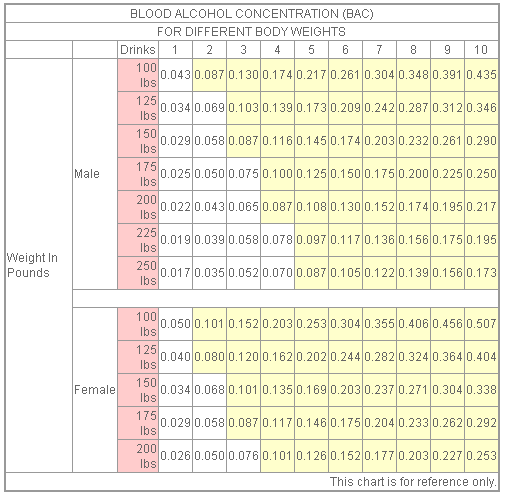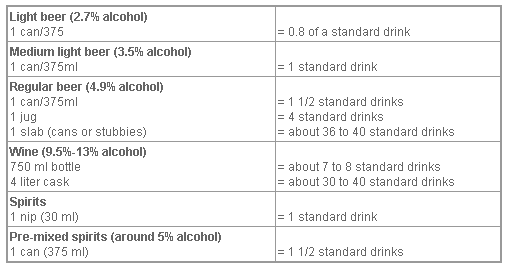-
Q: What is a standard drink and why?
A: The alcohol content of a standard drink is the amount of ethanol, not the amount of liquor you are drinking and not the number of cans, glasses or containers you use for the drinks. For example, drinking one standard unit of beer is equivalent to a distilled spirit. Definitions of “standard” drinks or units are useful information and guidelines to allow consumers monitoring how much alcohol they are consuming and to provide a reference point relative to what the potential risk the consumer may be involved.
-
Q: How many drinks does it take to be over 0.03% Blood Alcohol Concentration or 0.15mg/lire in breath alcohol level test?
A: There are many factors which effect blood alcohol concentration (BAC) such as gender, body weight & percentage of water make up, alcohol strength, recent consumption of food, health and how long after drinking the test is taken, etc. For instance, two glasses of alcohol beverage in one hour with no consumption of food may result in a positive test for the average male. Attached is a BAC chart detailing approximate levels for different weights. (For reference only)

-
Q: What is the Blood Alcohol Content limit for drivers in Taiwan?
A: The current legal limit is 0.15mg/litre for breath alcohol tests, approximately 0.03% Blood Alcohol Concentration. As drink-driving incidents are increasing annually, the Ministry of Transport and Communications submitted a higher legal limit to 0.15mg/litre in 2008 in an effort to decrease fatalities from drink driving.
-
Q: What is responsible drinking?
A: Responsible drinking means making sensible decisions in the consumption or non-consumption of alcohol. Many people enjoy drinking and find it a sociable and relaxing thing to do. However, there are things that you should not do before or after drinking, such as driving, operating machinery, exercising, work at heights or when taking certain medications. In addition, minors should not drink alcohol because they are not ready to deal with the physical and emotional risks of alcohol.
-
Q: What are the guidelines for low risk daily alcohol consumption?
A: Based on available scientific evidence provided by public authorities, including the World Health Organization, daily sensible drinking is 3 standard drinks for males and 2 standard drinks for females each day, and no more than 15 standard drinks for males and 10 standard drinks for females each week. The individual has to know their own personal limits for drinking alcohol as the level of alcohol consumption may differ for each individual.
-
Q: Why should women drink less than men according to UK guidelines?
A: Alcohol has a greater effect on women. A woman drinking the same amount of alcohol as a man will get intoxicated faster because she has a lower proportion of water in her body weight. Women therefore have a higher blood alcohol concentration in the body tissue and alcohol consumption may have a longer lasting effect. Attached is BAC chart for reference only.

-
Q: How do I calculate my unit consumption?
A: Alcohol has a greater effect on women. A woman drinking the same amount of alcohol as a man will get intoxicated faster because she has a lower proportion of water in her body weight. Women may therefore have a higher blood alcohol concentration in the body tissue and alcohol consumption may have a longer lasting effect. Attached is BAC chart for reference only.
Standard drinks in common containers of various alcoholic beverages:

-
Q: Can women drink alcohol during pregnancy?
A: Doctors recommend that you should not drink any alcohol at all during pregnancy. Limit or avoid drinking if you are trying to conceive and during breastfeeding as the alcohol will be absorbed into the baby’s bloodstream through your milk.
-
Q: Do all drinks contain the same amount of alcohol?
A: Alcohol is not what you drink but it is how much you drink. A glass of wine, a bottle of beer and a shot of whisky or distilled spirit is more or less the same amount of alcohol in most countries.
-
Q: After consuming alcohol, does the consumption of any other beverage help to reduce the percentage of blood alcohol concentration?
A: There is no evidence to show that consumption of any other beverage can reduce the percentage of blood alcohol concentration after consumption of alcohol. Alcohol is metabolized at a rate of 0.015mg alcohol/litter per hour in human body.

